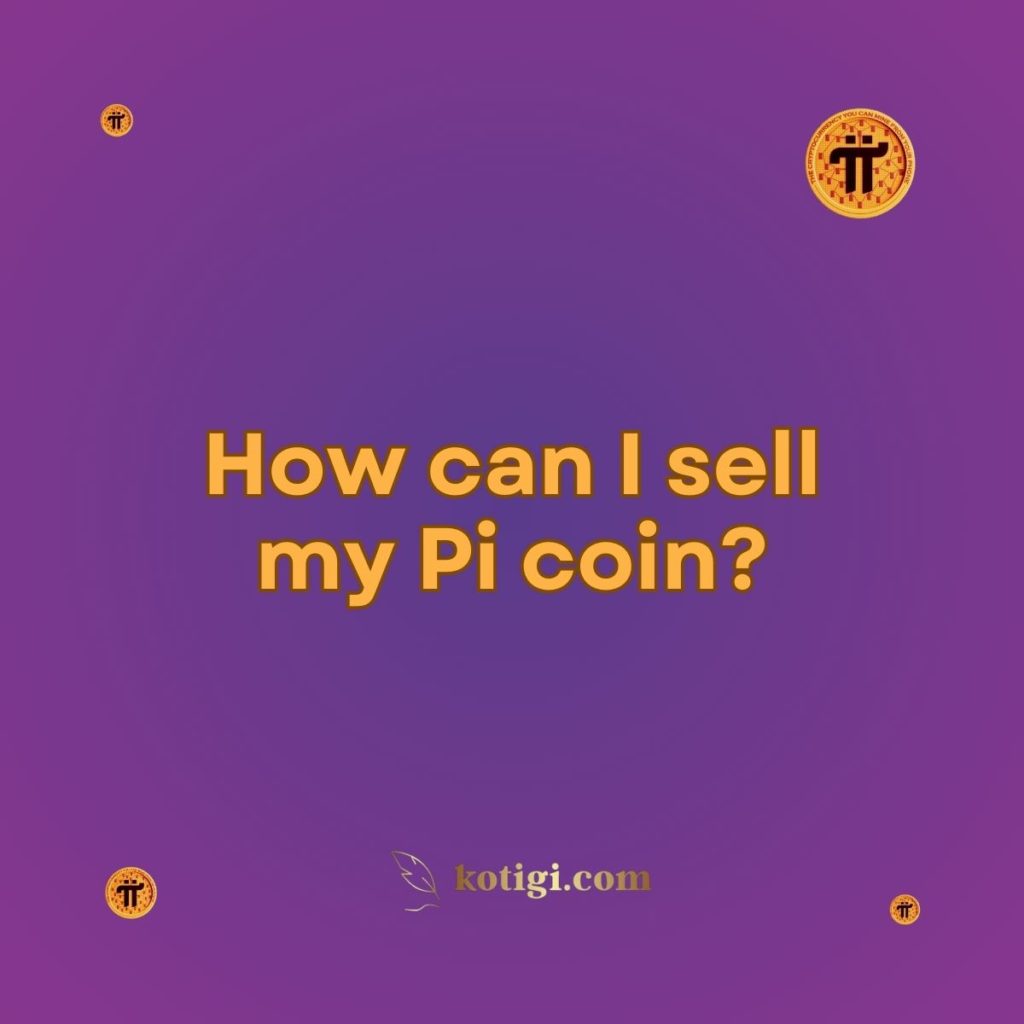
How can I sell my Pi coin?
Currently, Pi coins cannot be sold or traded on public exchanges as Pi Network is still in its enclosed Mainnet phase. However, once Pi transitions to its open Mainnet and is listed on cryptocurrency exchanges, users will be able to sell their Pi coins. In the meantime, completing KYC verification and staying updated on Pi’s progress are essential steps for future Pi transactions. Read on to understand the full process and what you can do now to prepare for selling your Pi coins.
Introduction
Many users, also known as Pioneers, who have been mining Pi on their mobile devices are eager to know how and when they can sell their Pi coins. With millions of people involved in the Pi Network, this cryptocurrency project has generated substantial interest. However, since Pi is not yet fully launched into the open Mainnet, it’s important to understand the steps necessary before Pi coins can be sold. This article will guide you through what you need to know about selling Pi coins in the future.
Current Status of Pi Network
What Is Pi Network’s Enclosed Mainnet?
As of now, Pi Network is in its “Enclosed Mainnet” phase, meaning that the Pi blockchain is live, but it is not yet connected to public cryptocurrency exchanges. This phase allows the development team to test the system in a controlled environment while improving network security and functionality.
In the enclosed Mainnet, users can still mine Pi coins and send transactions within the network, but they cannot yet sell or trade these coins on external platforms like Binance or Coinbase. This phase is crucial for ensuring that the network operates smoothly before it is opened up for public trading.
Why Can’t I Sell Pi Yet?
Since Pi Network is still in its enclosed Mainnet phase, the Pi coins mined by users have no real-world market value outside of the network. This means that Pi cannot be traded or sold on any cryptocurrency exchange. However, Pi holders are encouraged to complete their KYC (Know Your Customer) verification, which is required to transfer Pi coins in the future.
The transition to the open Mainnet is essential for users who want to sell their Pi coins. Once the open Mainnet is launched, Pi will become a publicly tradable cryptocurrency, and users will be able to sell their coins on exchanges.
Steps to Prepare for Selling Pi Coin
1. Complete KYC Verification
One of the most important steps to prepare for selling Pi coins is to complete the KYC (Know Your Customer) verification process. KYC is a standard procedure used by financial institutions and cryptocurrency platforms to verify the identity of their users.
To complete KYC on Pi Network:
- Open the Pi app and follow the KYC instructions provided within the app.
- Submit your identification documents (such as a passport or driver’s license) for verification.
- Wait for the Pi team to confirm your identity.
Completing KYC is necessary to ensure that you can transfer your Pi coins once the open Mainnet is launched. Only verified users will be able to participate in transactions and sell Pi coins on exchanges.
2. Monitor Pi’s Open Mainnet Launch
The open Mainnet launch is the key event that will allow Pi coins to be traded on exchanges. Currently, there is no specific date for when this launch will happen, but Pi Network is actively working towards this milestone. Pioneers should keep an eye on official Pi Network announcements to stay informed about the open Mainnet launch.
Once the open Mainnet is live, Pi will be listed on cryptocurrency exchanges, and users will be able to sell their coins just like other cryptocurrencies.
3. Use Pi Wallet for Enclosed Transactions
Even though Pi cannot be sold on public exchanges during the enclosed Mainnet phase, users can still conduct transactions within the Pi Network using the Pi Wallet. The Pi Wallet allows Pioneers to send and receive Pi within the enclosed network, which is useful for interacting with Pi applications or transferring coins between trusted users. However, these transactions are limited to the Pi ecosystem and do not involve external markets.
When Will Pi Be Tradable?
What to Expect from the Open Mainnet?
Pi Network’s open Mainnet will be the moment when Pi coins gain real-world value and can be traded on cryptocurrency exchanges. This phase will mark the transition from a closed, experimental network to a fully decentralized and open blockchain. When this happens, Pi will be listed on various cryptocurrency exchanges, enabling users to buy, sell, and trade Pi coins.
However, there are several factors that will determine when Pi will be tradable:
- Security Audits: Before Pi can be publicly traded, the network must undergo extensive security testing to ensure that it is safe and scalable.
- KYC Completion: The Pi team is focused on completing the KYC process for its millions of users to ensure compliance with global regulatory standards.
- Community Development: Pi Network is encouraging the development of decentralized applications (dApps) and real-world use cases for Pi, which will enhance the coin’s utility once it becomes tradable.
Exchange Listings
After the open Mainnet launch, Pi will likely be listed on popular cryptocurrency exchanges such as:
- Binance
- Coinbase
- Kraken
- Huobi
The listing of Pi on these platforms will open up trading opportunities for users. However, it is important to note that the price of Pi will be determined by market demand and supply, meaning that its value could fluctuate significantly after being listed on exchanges.
Risks and Considerations Before Selling Pi
Market Volatility
Once Pi is tradable on exchanges, users should be aware of the potential for market volatility. The price of newly listed cryptocurrencies can be highly unstable, and early trading periods often experience large price swings. It’s important to consider whether you want to sell your Pi immediately after it is listed or if you prefer to hold onto your coins in anticipation of future price increases.
Transaction Fees
Selling Pi on exchanges may come with transaction fees. These fees can vary depending on the exchange you use and the method of withdrawal. It is advisable to research the fees associated with your chosen exchange before deciding to sell your Pi.
Regulatory Compliance
Cryptocurrencies are subject to regulatory compliance in various countries. Before selling Pi, make sure that you understand the legal requirements in your region. In some countries, profits from cryptocurrency trading may be subject to taxation, so it’s important to stay informed about local regulations.
How to Sell Pi Once It Becomes Tradable?
Step-by-Step Guide to Selling Pi
Once Pi becomes tradable on cryptocurrency exchanges, here’s a general step-by-step guide on how to sell your Pi coins:
- Sign Up for an Exchange Account
Choose a reputable cryptocurrency exchange that supports Pi. Popular exchanges include Binance, Coinbase, and Kraken. Sign up for an account and complete the required identity verification process. - Transfer Pi to Your Exchange Wallet
After creating your account, you will need to transfer your Pi coins from your Pi Wallet to the exchange’s wallet. This can be done by generating a deposit address on the exchange and sending Pi coins to that address. - Place a Sell Order
Once your Pi coins are in your exchange wallet, you can place a sell order. There are two main types of sell orders:- Market Order: This order sells your Pi coins immediately at the current market price.
- Limit Order: This order allows you to set a specific price at which you want to sell your Pi. The sale will only execute when the market reaches your desired price.
- Withdraw Funds
After selling your Pi coins, you can withdraw the funds to your bank account or another cryptocurrency wallet. Be sure to check the withdrawal fees and processing times for your chosen exchange.
Holding vs. Selling
When Pi becomes tradable, some users may choose to sell their coins immediately, while others may prefer to hold onto their Pi in hopes of a future price increase. It’s important to weigh the risks and benefits of selling versus holding. Holding Pi for the long term could potentially lead to higher profits if the coin gains widespread adoption and increases in value.
Conclusion
Although Pi coins cannot yet be sold, Pioneers can take steps now to prepare for the future. Completing KYC verification and staying informed about Pi’s open Mainnet launch are crucial steps in getting ready to sell your Pi coins. Once the open Mainnet is live, Pi will become tradable on cryptocurrency exchanges, allowing users to sell their coins for other cryptocurrencies or fiat money. However, it’s important to be aware of market risks, transaction fees, and regulatory requirements before selling your Pi.
Key Takeaways:
- Pi coins cannot be sold until the open Mainnet is launched.
- KYC verification is required to sell Pi in the future.
- The open Mainnet launch will allow Pi to be listed on exchanges.
- Users should be aware of market volatility and transaction fees when selling Pi.
- Monitoring official Pi Network updates is essential for staying informed about when Pi becomes tradable.





